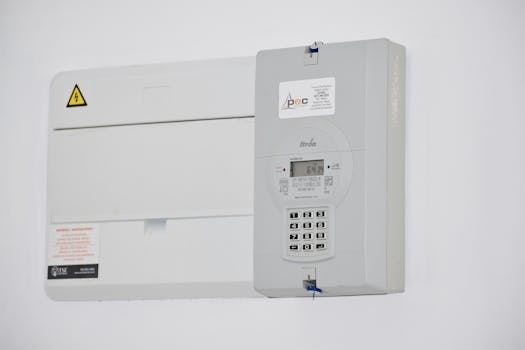Household Economy
How to Create a Household Budget That Covers Everything: A Step-by-Step Guide
Ready to gain control of your money? Learn step-by-step strategies to build a complete household budget, spot every expense, and adapt with confidence. Start budgeting like a pro today.
Advertisement
Feeling like your paycheck disappears without warning? You’re not alone. Many people try to track spending, but unexpected bills or missed expenses pull them off course from their household budget goals every month.
Getting your household budget in order means less stress about forgotten bills or surprise expenses. You’ll know exactly where your money goes, and can plan for the things you want and need.
This article breaks down exactly how to create a household budget that actually covers everything—from fixed bills to the little things you forget. Use these strategies to make every dollar count.
Building Your Budget From the Ground Up Ensures You Miss Nothing
Before tracking a dime, start with a blank slate. List everything your household spends money on, from utilities to work lunches. A full inventory ensures nothing slips through the cracks when creating your household budget.
Analogies help: think of your household budget like packing for a road trip. If you only remember the big things but forget your toothbrush or socks, you’re caught off guard later. That’s why you list everything upfront.
Brainstorming All Expenses Adds Accuracy to Your Plan
Grab a notepad or spreadsheet and jot down each category where your money goes. Include all recurring monthly bills, regular buys like groceries, and one-off costs that come up every year.
People say things like, “I didn’t realize how much I was spending on takeout until I wrote it down.” Listing everything, even small purchases, brings awareness fast. Use recent bank or credit card statements as reminders.
With each item, mentally walk through your typical week. Think about every stop, store, or payment due. This practical step uncovers forgotten costs and helps make your household budget comprehensive from the start.
Check Previous Months for Hidden or Irregular Expenses
Look back three to six months at your banking app or statements. Circle odd expenses: holiday gifts, school fees, car repairs, or medical visits. These pop up often enough to warrant their own budget lines.
If you spot seasonal patterns, add a small monthly allowance to your household budget for these. For example, if you paid $300 for back-to-school supplies in August, set aside $25 each month to smooth it out.
This approach removes the sting of big, irregular bills by making them predictable. Everyone has forgotten at least one annual expense, so plan for them like clockwork.
| Category | Example | Frequency | Takeaway |
|---|---|---|---|
| Utilities | Electric, gas, water | Monthly | Add a line for each to keep bills organized |
| Grocery | Food, cleaning supplies | Weekly | Calculate a realistic weekly average for accuracy |
| Subscriptions | Streaming, gym, software | Monthly/Annually | Audit all existing subscriptions and include infrequent charges |
| Annual Fees | Car insurance, taxes | Yearly | Divide by twelve and set aside money each month |
| Irregular Costs | Vet bills, home repair | Sporadic | Create a buffer fund for peace of mind |
Tracking and Categorizing Helps Spot True Spending Patterns
Knowing where the money goes ends surprises. Track every purchase for a full month to spot daily, weekly, and monthly habits. The more honest you are, the more accurate your household budget becomes.
Use digital or paper tracking—whichever feels easier. Real numbers matter more than perfect formatting. Refer to receipts or banking apps to stay consistent and complete.
Group Similar Costs to Uncover Saving Opportunities
After tracking, categorize expenses to shine a light on habits. Combine related costs—like coffee shop stops and restaurant lunches—as “Dining Out.” This broad view reveals patterns you may want to adjust.
People are surprised when small, frequent buys add up fast: “My daily coffee habit costs more than my monthly gym membership.” Organizing these helps you prioritize cuts without sacrificing things you value most.
- Group common purchases: Merge lunch, snacks, takeout under one “Eating Out” line in your household budget.
- Total by week: Add up amounts by week to find spending spikes and ‘normal’ levels, giving you a realistic average.
- Spot duplicates: Check for duplicate subscriptions or overlapping services. Canceling extras frees up cash quickly.
- Pull seasonal costs aside: Mark anything that only appears during certain months, like Halloween costumes or summer camps.
- Note surprise fees: List “bank fees” or “delivery tips” if they crop up more than twice per month.
By grouping, you make the next step—setting limits—easier and more accurate.
Actions That Let You Track Seamlessly
Set a calendar reminder every Sunday night to record expenses for the week. Regular check-ins prevent backlog and build a budget habit. If you miss a week, don’t sweat it—catching up is better than skipping entirely.
Use your phone’s note app or a basic spreadsheet labeled by week. Write, “Monday: $14 groceries, $6 parking,” and so on, for each day. Over time, this gives you trends to adjust as needed.
- Log new purchases immediately: If you buy lunch, add it to your tracker before you leave the table. Real-time tracking stops you from forgetting.
- Batch-enter receipts: At the end of each day, input receipts all at once. This habit keeps your household budget up to date without feeling tedious.
- Review at week’s end: Every Sunday, total your categories. Mark any surprises, overages, or under-spends for reflection.
- Get family involved: Let kids or a partner track certain categories, like groceries or entertainment. This shares responsibility and teaches transparency.
- Set milestone rewards: If you complete tracking for a full month, treat yourself to a small reward—a coffee or movie night—to celebrate consistency.
These hands-on steps reinforce the habit and keep your budget aligned with reality.
Monthly Net Income Sets the Perimeter for Budgeting Success
Your budget works only if you know exactly how much money arrives each month. Add up net income—after taxes and deductions—from all sources, including side gigs or support payments.
Net income is the fence around your spending park. Without it, you risk building a budget on sand and running short mid-month.
List All Predictable Sources With Dates
Write out each income source and the date you expect it to hit your account. “Paycheck: $1,500 on the 1st and 15th” or “Child support: $200, third Monday.” This approach avoids timing mismatches and cash flow gaps.
Adding up all after-tax earning helps you set proper limits. Gigs, commissions, or social security—it all counts, but only what you know for sure. This builds a dependable floor for your household budget.
Schedule a reminder to review income monthly. If anything changes, like a bonus or new source, adjust your budget lines before spending steps up.
Subtract Taxes and Other Non-Negotiables Before Planning
For those with fluctuating pay or self-employment, estimate taxes, health premiums, or business expenses and subtract them. Only budget what lands in your checking account after essentials.
“I get $3,000 a month, but my take-home is $2,300 after taxes and 401(k).” Build your household budget off the real number. This rule keeps you honest and prevents painful overdrafts mid-month.
Check year-end pay stubs for recurring deductions you may have missed. Adjust your numbers for any increases in insurance or changes to your retirement contributions as they happen.
Assigning Dollar Limits Creates a Safety Net, Not a Straightjacket
Once your expenses and income are clear, set spending limits by category. This isn’t about punitive rules—it’s about ensuring money goes where you want and need it to.
Give every dollar a job, even if that job is “fun.” Households that do this find leftovers for savings or extras nearly every time, even on tight budgets.
Order Priorities With a Realistic Approach
Start with must-pay categories: housing, utilities, minimum debt payments, and groceries. Next, earmark money for transportation, medicine, or insurance premiums. Work your way to less critical areas, like streaming services or hobbies.
“Rent: $900; Groceries: $350; Electricity: $95.” People often say, “I thought I’d cut takeout, but I need some wiggle room.” Splitting spending into needs vs. wants lets you adjust without feeling deprived.
Use buffers. If your car costs fluctuate due to gas prices, overestimate slightly. Better to have a small surplus than scramble for cash later. Safety nets create flexibility in your household budget.
Tweak and Test Your Limits Each Month
After living with your numbers for one pay cycle, review them honestly. Highlight categories that ran high and figure out why. Adjust by squeezing lower-priority lines and boosting high-priority ones.
Your first household budget might look good on paper, but real-life hiccups are normal. Reviewing receipts and looking for trends helps match your budget to your lifestyle, not the other way around.
If entertainment spending blew past your target, consider shifting dollars from another, less-used category. Each cycle is a chance to get closer to your ideal mix.
Building Flex Funds and Emergency Buffers Into Your Plan
No matter how careful you are, surprises crop up—a broken appliance or a last-minute trip. Including a flex fund softens their blow and protects your budget from getting derailed.
This flex fund doesn’t need to be huge at first. Even $25 to $50 set aside each month adds up, giving you breathing room when life throws curveballs.
Structuring Buffers Without Disrupting Everyday Spending
Make your flex fund its own category in your household budget. Label it “Miscellaneous” or “Unexpected.” This keeps it visible and prevents raiding other categories for sudden needs.
“Miscellaneous: $50 per month—for surprise birthday gifts or urgent school supplies.” If unused, roll the leftover into next month’s fund or a growing emergency stash. This rolling buffer builds resilience over time.
Visualize your buffer as a shock absorber in your car. It’s not flashy, but it stops bumps from becoming disasters. A small cushion often means you won’t dip into savings for simple surprises.
Emergency Fund Strategies for Added Security
Beyond monthly buffers, build an emergency fund for bigger setbacks—like job changes or unexpected medical bills. Start with a goal of $500, then work up to covering three months’ expenses if possible.
Set up automatic transfers to a savings account earmarked only for emergencies. Even $10 to $20 per paycheck makes a difference when done routinely, and you’ll be grateful it exists when a true crisis hits.
Tell yourself, “This fund is for real emergencies, not planned expenses or sales.” Sticking to this rule means you’ll have help waiting when you need it most, keeping your household budget stable during chaos.
Saying Yes and No With a Purpose—Communication Makes Budgeting Work
The best household budget works when everyone involved knows their role and helps make decisions. Regular conversations about priorities and choices set clear expectations and reduce friction later.
Agree in advance on spending rules, treats, and sacrifices so nobody feels blindsided. Transparency leads to fewer misunderstandings when bills or opportunities come up.
Family Meetings Keep Everyone on Track
Schedule a brief money check-in each month. Pull out your household budget and update it together. This scene might include kids adding their wish-list items or a spouse flagging upcoming travel or projects.
“We have $50 left for entertainment—shall we use it for the zoo or movie night?” Directly involving everyone minimizes surprise spending and teaches collaboration around money without tension.
Set the expectation that plans may shift. If a big bill comes up, discuss where cuts could happen. “If we pull $20 from dining out, we can cover the extra soccer fees.” Teamwork sharpens your budgeting skills as a family or household.
Scripts for Real Conversations That Build Buy-In
Use simple, direct language to address trade-offs: “We can afford this, but we’ll need to spend less on something else. Would you rather skip takeout or hold off on a new game this month?”
Point to the numbers, not the person. Swap criticism with curiosity: “I noticed our electric bill went up—should we unplug gadgets at night or check for leaks?” This keeps the focus on improvement.
If someone is nervous or frustrated, invite ideas: “What’s one category you want more flexibility in? How could we make that work?” This fosters creativity and compromise, building a resilient household budget.
Staying Consistent While Adapting as Life Changes
Your household budget isn’t set in stone. Birthdays, new jobs, or unexpected moves all bring shifting priorities. Regular reviews let you evolve your categories and keep goals relevant.
Quick checks every few weeks help spot changes early. Is a cost creeping up? Is there a windfall you can direct to savings? Adjust your plan as needed for a true fit.
Checkpoints and Adjustments That Make Habits Stick
Set recurring calendar alerts to review your household budget twice a month, ideally after paydays. These check-ins let you see if you’re over or under in any category before bad habits set in.
“We’re halfway through the month and groceries are almost gone—let’s plan three pantry meals and skip eating out.” Tiny corrections like this help your budget flex to reality.
If you see a surplus, decide as a group where to move it. Maybe put extra cash toward the emergency fund or a future family outing. This gives everyone ownership in the budgeting process.
Celebrate Milestones and Reset When Needed
When you hit a goal—pay off a credit card, save for a trip—pause to celebrate. Marking wins reinforces the habit for next month. “We made our household budget work for six months—let’s treat ourselves to takeout tonight.”
Unexpected expenses can knock your plan off course. When they do, regroup instead of blaming. “Let’s suspend fun spending this week to cover the vet bill, and get back on track next month.”
This flexible mentality supports consistency and progress, keeping the process sustainable regardless of setbacks.
Conclusion: Bringing It All Together for a Flexible, Complete Budget
Building a thorough, honest household budget means listing every regular and surprise expense, setting spending rules, and making room for life’s twists and turns. Stay active in reviewing and tweaking your plan as you go.
With practical tracking, teamwork, and regular adjustments, your budget won’t be rigid—it’ll act as a supportive guide for your unique lifestyle. You’ll relieve daily stress and open up more options regardless of income size.
If you approach budgeting as an active, evolving tool, you’ll find more confidence in your financial decisions and reach meaningful goals that might have felt out of reach before. Take that first step, and improvement follows.
Frequently Asked Questions
What if new expenses pop up after I budgeted for the month? Unexpected costs are almost guaranteed. Create a “miscellaneous” or flex fund category in your household budget. If something big hits, review your categories and shift funds, then address why it was missed for future months.
How detailed should I make my categories? Aim for a balance. Too vague, and you won’t see what needs fixing. Too granular, and the process gets overwhelming. Track every area that influences your spending behavior or often surprises you. Adjust category details over time.
Can I budget only with cash, or should I use digital tools? Both methods work. Some find that cash envelopes help curb spending, while others prefer the convenience of apps or spreadsheets. Choose the approach that you’re most likely to maintain with consistency.
What’s the most common mistake people make? Forgetting infrequent or annual costs tops the list. Scan past statements for every yearly or quarterly bill and add a small monthly line for each into your household budget. This spreads out big payments over time.
How long does it take for a budget to feel natural? Most people need two to three full months to adjust. Expect to revise categories, fix underestimates, and smooth out hiccups. Stick with it through early challenges; consistency makes managing a household budget easier as new habits form.





